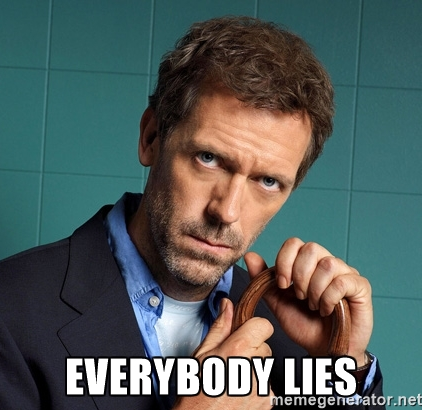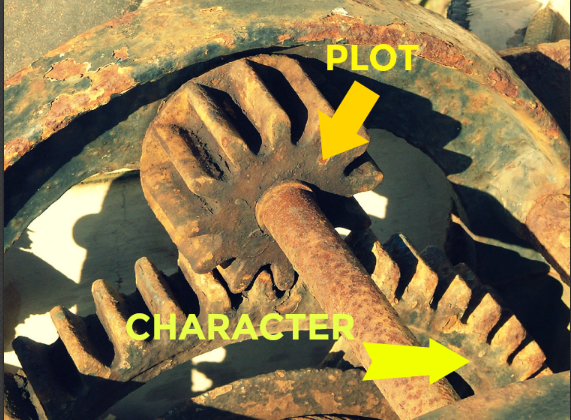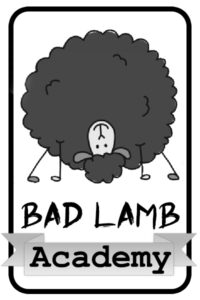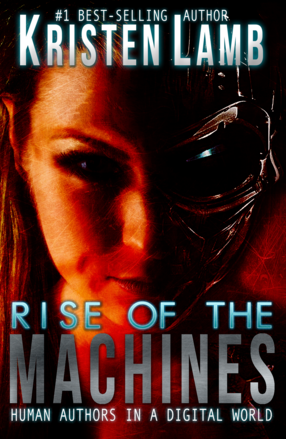
Many emerging writers come to me when they find they are struggling with their WIP. I always begin with the same question, “What is your story about?” Often, I get this response, “Well, my story isn’t plot-driven. It is a character-driven story.”
Translation?
I have no plot…and please stop asking me because it makes me want to drink heavily.
There really is no such thing as a purely character-driven story. Character and plot are like two keyed cogs. One drives the other. The plot pushes the protagonist to grow and as the character grows, this in turn drives the plot.
For instance, in The Lord of the Rings the plot problem (Toss evil ring in a volcano before power-hungry necromancer takes over Middle Earth) is what forces the Hobbits to leave The Shire. Ah, but once they leave, how they respond to escalating threats determines plot.
For instance, they are barely out of The Shire when Merry and Pippin nearly get them all captured/killed by The Black Rider because they are running from an angry pitchfork-wielding farmer.
That is an ok place to begin, but what if they all remained the same reckless naive Hobbits they were in that scene? Their decisions would impact the story and they would fail.
To succeed, they must grow.
Granted, though we do have two cogs, depending on genre, this will impact the SIZE of each cog. In a Jack Reacher thriller? The plot cog is larger (but the character cog is still there). Similarly, in a literary fiction, this will reverse. In Cormac McCarty’s The Road there is still a plot objective (Make it to the ocean) but the character cog is larger because reaching the goal is far less important than HOW they reach the goal. If Man and Boy stop to snack on people? They fail. The torch of humanity is extinguished.
Thus, a literary work (character-driven story) might work like this…

For genre fiction, it would reverse and, depending on the story and the style, the relative size of the cogs will change accordingly. Yet there will always be two cogs.
Regardless of genre, once we have an idea of what our story is about and have set the stage for the dramatic events that will unfold, we must remember that fiction is about PROBLEMS. Plain and simple. Furthermore, it is about PEOPLE who have problems. But not simply ANY problems. Very specific problems, which we will talk about in a sec 😉 .
I will say that plot is very important. Our characters are only as strong as the crucible. Ultimately, all stories are about people. We might not recall every detail of a plot, but we DO remember characters. Ah, but here’s the sticky wicket. WHY do we remember characters? Because of plot. Stories are more than about people.
Great stories are people overcoming great odds.
If we’re missing emotional connection between the audience and our characters, our story loses critical wattage. What are some ways we can help form that connection? Today…
The Wound
Real humans have wounds that drive our wants, needs, perceptions, and reactions and so should all our characters (even the Big Boss Troublemaker-Antagonist). Maybe your character is a control-freak. Perhaps he avoids. Maybe she is battling an addiction or is a loner or is a people-pleaser. Maybe he is a user or a manipulator.
My question is WHY?
Yes, genetics will have a role in forging our personality, but genes do not a good story make. Having a character be a certain way simply because we need them to be or act that way will work, but so will a heart with damaged valves.
Wounds drive how we perceive our world, what we believe we want, and how we will (or won’t) interact with others. This is critical for generating story tension and character arc.
I used the meme of Dr. House and his motto, Everybody lies. Yet, part of why that character was so successful is that we know something happened somewhere in the past that gave House that core belief.
This belief is what made him a superlative doctor, but it also hobbled every single relationship he ever had. We wonder about the wound because in every episode?
We see that wound in action.
Wounds are the NOTCH That Engages the GEAR
Back to my gear metaphor, but let’s expand it a bit. Think of plot like gears on a bicycle. So long as the gears are engaged and moving forward we have story momentum. Character is like the chain winding around those gears.
Some of you might be old enough to remember riding a ten-speed with the old shifters. You had to practice shifting gears to get the chain to engage a larger or smaller gear and if you didn’t get it right? The pedals spun and the bike just made weird noises. That’s because the chain has to be able to meet with the teeth of the gear via a space or a hole…or it won’t work.
Character functions similarly. We can have the gears (plot) and the chain (character) but if there is no notch (wound) that allows them to ever mesh and create tension? The story has no momentum and just makes weird sounds while we fruitlessly spin literary pedals.
Wounds are the sweet spot, that hole, that allows plot and character to merge into dramatic momentum.
Some writers start with characters and others start with plot. It doesn’t matter so long as you let either be forged with “the wound” in mind. If you have a mental snippet of a rebellious renegade bad@$$ heroine and want to put her in a story, then think of a plot situation that will make her utterly miserable. She can’t grow if she’s comfortable.
Maybe instead of chasing bad guys, she is forced to become the caretaker for her three young nephews after her sister dies. This PLOT is going to force her to be vulnerable, maybe have a softer side, and lighten up. Now, character (chain) and plot (gears) are linked.
Same if we go the opposite direction.
Maybe you have a great idea for a story. You want to take down a mob boss. Who can you cast that will be the most uncomfortable and thus grow the most? A former hit man who’s given up killing because he promised his wife before she died? An agoraphobic ex-cop who can’t leave her house? A sweet, naive soccer mom who believes that Bedazzling makes everything way more AWESOME?
Genre will dictate some of the casting, but note if we cast someone who would reach our story goal with relative ease, we risk having a one-dimensional talking head. We also diminish tension because remember, readers LOVE seemingly unbeatable odds. So, if we cast a highly decorated detective to take down our mob boss, make sure there is something about him (a wound) that puts the odds against him.
Wounds Don’t Have to Be Big to Be BIG
Often, new writers will default to wounds like rape or death or some big tragedy to create the wound. To be clear, I am not saying these aren’t viable wounds, but never underestimate the “smaller” and more relatable emotional injuries. The more a reader can empathize with one or more characters, the deeper that connection becomes.
Not everyone has lost their family to a sudden alien invasion— 😉 — but they can empathize with maybe never living up to expectations, being bullied, or not fitting in. LOTR rests on a small band of Hobbits who believe they are too little to make a BIG difference.
Perhaps the character is the invisible middle child trying to forge an identity, the eldest trying to hold the world together, or the baby who “got away with murder” and “was handed everything.” Never underestimate family dynamics as sources for realistic and powerful psychic wounds.
Wounds Will Distort Happiness
Wounds generate illusions. Because I grew up poor and lived hand-to-mouth all through college, I “believed” that money and financial security would make me happy. At 27, I made more money than any person in their 20s should make…and I was miserable. I was eaten alive with emptiness. I’d achieved all that should have filled that hole—the college degree, the premium job and premium pay. And yet?
I was the person stranded in a desert gulping sand I believed was water from an oasis.
Character arc comes when a protagonist is placed in a problem strong enough to challenge the illusion and break it. The protagonist believes X=happiness/fulfillment. It is only through the story problem that the protagonist rises to become a hero, a person capable of realizing they were wrong and that they’d been coveting a shill at the expense of the gold.
Thus, when creating characters, keep the wound at the forefront of your mind.
How does it affect what he/she believes about their own identity? What do they believe will make them happy? What is it that you (Author God) know that’s really what will make them happy? What needs to change for that character to lose the blinders? What is the perfect problem (plot) to force the protagonist to see the hard truth of the unhealed wound?
What are your thoughts? Writing can be healing and therapeutic. Have you ever siphoned from your own hurt-reservoir to deepen your characters? Can you think of how even small hurts can become super-sized? What are some ways you’ve witnessed wounds driving people in wrong directions toward false happiness? Have you been there, done that and earned the t-shirt?
I love hearing from you!
And to prove it and show my love, for the month of DECEMBER, everyone who leaves a comment I will put your name in a hat. If you comment and link back to my blog on your blog, you get your name in the hat twice. What do you win? The unvarnished truth from yours truly.
I will pick a winner once a month and it will be a critique of the first 20 pages of your novel, or your query letter, or your synopsis (5 pages or less).
November’s winner of my 20 page critique is Nancy Segovia. THANK YOU for being such an awesome supporter of this blog and its guests. Please send your 5000 word Word document (double-spaced, Times New Roman Font 12 point) to kristen@wana intl dot com.
Check out the Upcoming Classes
Remember that ALL CLASSES come with a FREE RECORDING so you can listen over and over. So even if you can’t make it in person? No excuses! Fantastic as Christmas gifts *wink, wink, bid, nod*
All you need is an internet connection!
NEW!!!! IDEAL FOR CHRISTMAS!!!!
Branding Master’s Class Series with Kristen Lamb THREE social media classes, ONE low price. Only $99. It is literally getting one class for FREE!!!!
Craft Master’s Class Series with Kristen Lamb THREE craft classes, ONE low price. Only $89. One class is FREE!!!! Includes my new class The Art of Character.
Individual Classes with MOI!
Blogging for Authors December 9th, 2016
Pitch Perfect—How to Write a Query Letter & Synopsis that SELLS January 6th
Plotting for Dummies January 7th, 2017
When your Name Alone Can SELL—Branding for Authors January 13th, 2017
Social Media for Authors January 14th, 2017
NEW CLASS!!!! The Art of Character January 27th, 2017










56 comments
8 pings
Skip to comment form
Personally, I would love to read that story about the Bedazzling soccer mom taking down a mob boss. The odds would be so far out of her favor it would feel like she just can’t win. 😀
I understand the importance of main characters having mental wounds that determine their actions, but what about minor characters?
Author
Everyone is wounded and as the late great Blake Synder said, “EVERYBODY ARCS!” So yes yes and MORE YES!!! The more wounds the more notches and thus the more momentum if done properly.
I don’t develop my characters like that. They just happen when I write, and I don’t think about wounds or little hurts or really anything like that. It mystifies me when people talk about character arcs–I just follow the front of the story and trust that things will work the way they’re supposed to.
And I have actively stayed away from using “wounds.” I’m a Desert Storm veteran, and everything I wrote after the war was very dark. It was so dark that even the dark genres didn’t want it. Worse, I had no idea I was writing so dark until other writers told me I was! I read Phil Clay’s book Redeployed cover to cover for a review (I doubt if anyone else read the entire book), and I didn’t want my writing to be like that. He was writing for therapy, and it was unreadable. So I’ve had to make an active effort to discard dark ideas and not let my stories veer into that dark.
Dark to light is a great arc. So is broken to whole.
I think the main thing is that the characters need to have changed in some way by the end of the book (unless they’re Indiana Jones) and the change needs to come out of what happens in the plot.
But hey, it doesn’t really matter whether you get there by instinct or planning, as long as you come out the other end with a workable story.
I can’t do dark at all. Every time it tries to come in, my muse grinds to a halt and waits for me to kick it to the curb.
Author
Well not all writers write dark but not all readers like dark stories. Still have to have wounded characters, just wound differently 🙂 .
I can do dark(ish) but I keep drifting to my instinct of putting in laughs, which doesn’t work so well, tonally.
You can be wounded and funny. I think it was Hawkeye in M*A*S*H* that said “You laugh so you don’t scream.” Something like that. Humour can be a defense mechanism.
True! It’s solemn-dark (like a Greek tragedy) that I can’t do. Still like to read it, though. Despairing-dark, on the other hand, I don’t like to write or read.
Reblogged this on Jeannie Hall Suspense.
Now I’m worried one of my two main characters isn’t wounded enough. I have to make her hurt more.
Hi Kristen.
Love the gear / notch metaphor. Now you’ve got me wondering if I need to deepen or add a few notches.
If someone can tell me the plot of “A Gentleman in Moscow” that’d be great.
It was truly a beautifully written 500 page tome on Russian manners and upscale dining clashing with communist ideals until the last 50 pages when the protagonist suddenly had a goal. Oh! And footnotes! Lots and lots of footnotes scattered throughout a NOVEL!
Great stuff, as usual, Kristen. Having just virtually attended one of your WANA classes I love the way your messages all dovetail. Us wanna-be writers are the “wounded” indeed and you’re our heroine guiding us through our story arc.
Author
Awwww ((HUGS))!!!
There’s only one thing worse than being wounded, and that’s not being wounded. Nice post Kristen.
Another beaut of a blog, Kristen. It’s a real challenge to write if you come from a background of trauma. Your initial inclination may be to avoid it, and writing too dark can be overwhelming for readers. ”Sopranos” creator David Chase based the character of Livia on his own mother, likely a borderline personality. “Lord of the Rings” author Tolkien likely drew upon his experiences as a WWI soldier when writing; Steinbeck traveled with migrant workers and later wrote “Of Mice and Men.” For creatives such as writers, musicians, artists, etc., pain and/or desperation can lead to breathtaking achievements.
Maybe it’s a matter of time – to distance yourself, get therapy, whatever you can – and then try to write from pain. To manage it, somehow.
This weekend, I watched a little of “A Beautiful Mind,” John Nash’s struggle with mental illness. And several weeks ago, my husband and I went to see “Hell or High Water,” a splendid movie about desperate brothers and a Texas Ranger out to bring them to justice. Very compelling viewing, and those are the stories that stay with me. I’ve heard that “Manchester by the Sea” is really wonderful, too, and again, about tragedy and loss. I watch “Ordinary People” now and then to watch a family collapse and come together again.
Probably what helps these dark ventures into storytelling most of all is humor – at times, dark humor. “The Sopranos” had so many laugh-out-loud lines, as well as horror, revulsion, violence, etc.
Otherwise, a story can feel shallow. Unsatisfying. Forgettable.
Even the best rom-com’s – which are purposely light – have some degree of pain.
Tracey Ullman has a new HBO comedy show, and in one skit, plays an intense male acting coach. “He” (Tracey) summons two hesitant acting students up to the “stage,” and then assigns them impromptu roles: “You’re the nasty, lascivious landlord and you’re the drug-addicted mom-to-be who can’t pay rent. GO!” The two young people shuffled around, mystified as to what to say or do. They were almost polite to each other, saying lines they might have lifted from films because they couldn’t come up with their own, (due to their idyllic upbringings).
Kristen, we’ve talked about the romance genre and the emphasis on the idealized, kick-butt heroine. How another genre can make a bestselling hit out of “Girl on the Train,” but the current climate in romance will never allow for a fractured, vulnerable, struggling heroine. I scan many blogger reviews that condemn a romance novel’s “Mary Sue” heroine. Inevitably, I scroll down to read comments, usually those applauding the evisceration of the female heroine. Seems that romance reviewers adore the snarky, superior heroine – a character I cannot relate to. I enjoyed Katniss but I guess I see “Hunger Games” as a fantasy, much how I view comic book movies. Human beings do not have super powers, and the best stories, the most compelling and real stories, usually come from suffering.
“…the current climate in romance will never allow for a fractured, vulnerable, struggling heroine… Seems that romance reviewers adore the snarky, superior heroine – a character I cannot relate to… Human beings do not have super powers, and the best stories, the most compelling and real stories, usually come from suffering.”
I couldn’t agree with you more, Renee. I’m sick of self-sufficient (usually skinny and fit, to add insult to injury) heroines. I’m writing an ordinary one in my novel – with a lot of self-doubt and a not-perfect figure. I know there will be many who condemn her as a ‘Mary-Sue’, but surely there will also be some who are crying out for a heroine they can relate to? Well, if nothing else, *I* will be able to relate to her 🙂
Author
Sometimes I think that is why stories like these just get shelved as Fiction and not Romance.
From what I remember, Katniss in the books was NOT a superpowered conquistador. She got things done, but… the overall theme of the book involved her breaking to pieces internally as she went deeper and deeper into just HOW broken and horrible the world around her was, and how many users there were. She wasn’t powerful, she was HARD, and there is a difference. A hard woman can actually be all wound on the inside, surviving by being willing to do anything to survive.
Someday I plan to write a story about a girl/woman who DOES have superpowers, with a major theme of the story being that superpowers are useless if the person who has them can’t find a way to function as a loving human.
For a romance (have a first draft that IS THIS, actually), make a woman who is a total combat fiend on the outside, but is broken and raw and longing to find a home on the inside, yet can’t conceive of how to live without that protective shell. Then pair her with a man who is brave and good but not a classically competent hero (rescues through other means than being good at blowing people’s brains out. Has to delegate, design, make deals, get help, outsmart, or use sheer force of will and determined searching to protect, but DOES protect). Then the woman is both the empowered woman, AND the real woman who just wants to be loved, and the man is real and respectable without being The Jock.
By the way, I LOVE that gear visual. That is fabulous and helpful.
Maybe money didn’t make YOU happy, but I guarantee you it would erase all the problems making me unhappy. This reminds me of something I hate about plots of stories: The character who gets whatever they want then realizes they already had everything they needed to be happy. I HATE this plot device, which I see a lot. I realize some people must like it because obviously it sells books, but I don’t. Sometimes you know what you want and it’s not what you already have. Quit trying to convince everyone they should be happy with what they already have, writers. Some of us aren’t buying it.
I read an interested definition of plot vs. character driven stories years ago. It went something like this:
Plot-driven: The queen dies. Then the king dies.
Character-driven: The queen dies. Then the king dies…of a broken heart.
I’ve always thought of “literary” stories as those books you read that have no real plot but lots of colorful and often amusing description. Kind of the Gilmore Girls of books.
Author
I dunno. I think what you are talking about is an over-simplification of what I am talking about. The protagonist learns what they thought would make them happy isn’t the ONLY thing that would make them happy. Say it is money. Sure the money comes and tangible world problems are solved. But in the beginning, the character is unaware that there is actually more amiss than simply needing rent money or a new car. The plot shows the WHAT ELSE is missing that the protagonist is unaware of in the beginning. Otherwise, it is too simple of a plot because plot isn’t merely about solving outside “bad situations” but also peering to the INSIDE of the character and shining a light on what is missing OTHER than surface elements.
With your example? They are both present. One is the plot cog and the other is character. We need both or we have a half-baked story.
Yes, I agree. I just think character should move the plot forward rather than a random stream of events. This happened, then that happened, then this happened…not a plot IMHO.
Author
And THAT is correct. They are an escalating series of events that are always tethered to solving the core OUTSIDE problem yet they also reveal then solve the internal one as well. Most often it is a problem the protagonist was unaware he/she had in the beginning. Otherwise we have soap opera writing 🙂 .
I liked the post, but the gear analogy broke for me when Character went from a gear to a chain. Cheers!
Author
Yeah well sometimes modifying the analogy works and sometime not so much :D. But at least you got part of it. But if you think about it the chain serves as a variant of a cog. It has teeth, it is round(ish) and it is dependent on the main gear system. It is just a different sort of cog 😉 .
🙂
Reblogged this on Me, My Books, and I.
I found the “wound” idea to be very helpful. As a struggling beginner (one novel finished?), I am surprised at what I didn’t know, even after teacher literature for 35 years. I think I did include the wound in the protagonist of the novel, but I am thinking deeply about the second. Thanks for the great, informational blog.
Love, and look forward to your posts Kristen! I always feel unprepared when someone asks me what my story is about. Usually they end up staring at me with glassy eyes and hurrying from my presence. Considering the wound will help me create better stories. Thanks!
Superb article, many thanks. I’ve returned to the plan for the last quarter of my novel and added more emphasis on my MC’s wound – her lack of self-belief – and it’s added a depth I knew was missing but wasn’t sure how to rectify. Thank you.
Author
Careful here, because if that is the wound, she should have evolved beyond that by the last part of Act Two and Act Three she triumphs over it. Otherwise she is hard to root for.
That’s good advice, thanks.
Good advice. Perhaps the wound could also be called “the big lie”. Something in the character that does not match reality, because of something that was done to them, even if that something is just that they were raised in a culture that has some really big lies, (like an American Materialist being thrown into a situation where problems can’t be covered up with money or possessions).
Linked back to this with a short post on my blog.
Reblogged this on Nancy Segovia and commented:
Wounded characters make good plots better
It would be awesome for you to read my books. But, they are already published. I take it this is for books in the works?
I have been through a lot-healthwise. From near death in 1997 to now, I use my struggles in some of my characters.
Even though one was a vampire and another a tortured werewolf, I loved using my inner turmoil to flesh out my characters. It makes them ‘real’.
Author
The contest? I will read whatever you want me to but if it is already published you might not want me to 🙂 .
Why would I not want you to read my published works?
I have a vampire novel and a sequel, a tortured werewolf novella, 2 children’s Halloween short story books, a children’s short story about a troll(my 1st book) and an inspirational book about a family coping with their mom’s breast cancer diagnosis(it’s also a short story).
Author
I am a really tough editor and if I go ripping through it’s a tad after the fact if it is published. I don’t know your skill level but I have had folks send me 20 pages who won and I shredded their pages and they were distraught because nothing they could do. I guess if you just warn me first then I will critique differently *shrugs* .
Reblogged this on ichbinmeisterin and commented:
Inspiring words from Kristen Lamb on the power of the WOUND in writing! Well worth the read, as usual.
Reblogged this.
Excellent advice.
Brilliant, as always. I always learn something from you.
Interesting analogy. I’ve always found that saying a story must be character driven ignores the reality that some of the most popular novels are plot driven. For example, Clive Cussler reuses characters that are stereotypical for the action/adventure genre. It works because, despite the cookie-cutter characters. he tells a great story that doesn’t strain the brain. The goal, after all, is entertainment, not enlightenment.
I am *so* glad to see someone break down the wall between “character-” and “plot-driven” stories. Of course there are differences, but they fit together and there’s no single division between them. Cogs of different sizes, yes.
I think the key is which has more control over the character’s choices. If someone’s running for her life, the situation limits her to the point that it’s hard for her to establish much about herself besides her track speed. If she simply finds out there’s a killer in town after her, we get to see if she reaches for a gun, a phone to the police, a friend, or a plane ticket, and in what order. And if there is no killer but just a rough day at a job where she sets her own hours and rules, pretty much everything’s defined by her.
And of course, of course, the real key is how well they match. A woman who likes Bedazzling isn’t a story in itself, and a mob boss taken on by “just a cop” isn’t much of one either.
I also left the following comment about this post on my own blog and linked followers back here.
This is actually the first time I ever had an “Aha moment” while reading the advice of another writer. As you can see in one of my other posts, “Writerly Advice, (NOT)” I’m not one who encourages new writers to listen to those who make a career of advising writers as a way of learning how to write. Sometimes such advice can damage you by making you too self-conscious while you’re trying to write the next great American novel. Well, I take it back. Some advice from some advisors is brilliant and well worth reading, re-reading, and studying. The Following post by Kristen Lamb is just such advice. Have a look at the article called
The Wound—Because Damaged People Make the BEST Stories
and see what you think. I think I’ve always done this. For instance, I’m writing a fantasy containing lots of content from the King Arthur legends but giving the legends a new twist. In the legends King Arthur is almost a comic book type superhero who is perfect, not flawed. Another name for the wound, a name I learned from my senior year high school English teacher is, “the tragic flaw,” – the character’s weak spot, his or her undoing. I agree it’s the thing that moves plots BEST and after reading Kristen’s description of how to do it, I know I can do it better. Thank you Kristen!
Here is the link to Kristen’s blog page: https://warriorwriters.wordpress.com/
For em this is am very timely blog post. I have been really buckling down with my writing lately,and because of that I discovered I am not as much of pantser as I am a plotter. And part of me being a plotter is writing out short stories about moments in my main protag’s life. As i was reading this post I realized that i had given my character a wound and while I have been touching on it, I need to bring it out a lot more. She is a little TOO confident when her wound should be sapping that trait.
So, sincerely, thanks for that!
Something I think bears elaborating is the statement “genes do not a good story make”. Initially, I was skeptical, admittedly for self-serving reasons, since a fair bit of conflict in my WIP is driven by two characters who are monsters by nature – their struggles with overcoming that nature, concealing it from others, conflicts between the one who deals via repression versus the one who tries to find a balance, etc.
But I realized that genetic monstrosity isn’t *that* compelling. Nothing interesting happens if they just sit in a corner and mope (no plot), or if they’re perfectly well-adjusted people/monsters who manage to cope with everything life throws at them. What makes it compelling is that on top of that monstrosity are wounds from their personal history (guilt, failures) and how the plot rubs salt into those wounds until they are both driven to their darkest hours.
That said, given that most everything I write has a level of comedy/levity to it, I think a character with no wounds, no blind spots, etc. could be highly amusing as a comic foil for the other damaged characters. Every comedy needs a straight man to insist that, in fact, this parrot is deceased!
Great post! I think who we are naturally comes out in our plots and characters. It’s channeling these hurts and then picking the right character to bear them. Sometimes I believe our hurts come out as we right on accident too. Thank you for the advice.
Reblogged this on authorkdrose.
I get it. Thanks for the great visuals. But…you mean my bike is old?
I like this advice. I never really thought about how you put the whole story together but what you have said makes absolute sense.
This was such a great article. Thank you, Kristen Lamb!
[…] via The Wound—Because Damaged People Make the BEST Stories — Kristen Lamb’s Blog […]
[…] This HERE is an excellent post by Kristen Lamb on the relationship between plot and character in driving a story. It also deals with the necessity of the Wound in character development, laying it out as the thing which warps or determines the beliefs of the character and which, by forcing conflict, will cause the character to grow. Or at least make for an interesting story. […]
[…] The Wound—Because Damaged People Make the BEST Stories […]
[…] « The Wound—Because Damaged People Make the BEST Stories […]
[…] via The Wound—Because Damaged People Make the BEST Stories — Kristen Lamb’s Blog […]
[…] https://warriorwriters.wordpress.com/2016/12/05/the-wound-because-damaged-people-make-the-best-stori… You need the wound to drive the plot and character. […]
[…] characters entice readers. Kristen Lamb explores the Wound and the Blind Spot to enhance your characters, A. Howitt describes the how and why of making it […]
[…] The Wound—Because Damaged People Make the BEST Stories […]